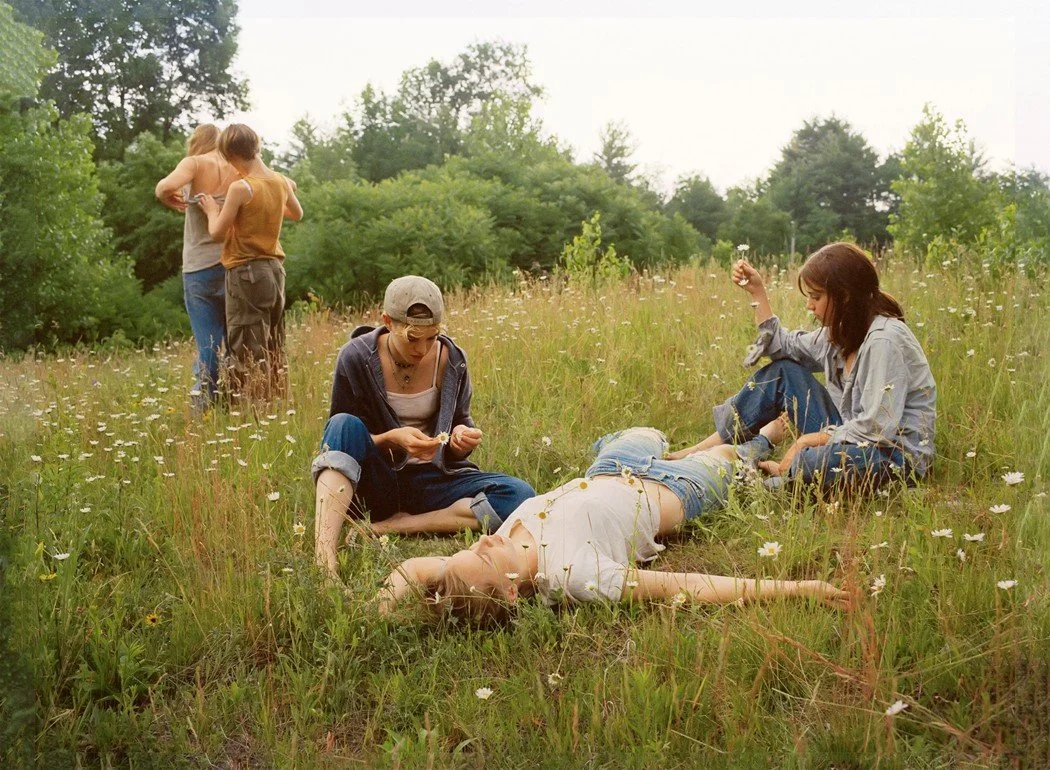Justine Kurland: Photos From a Lost Girlhood
Words by Maya Bewley
I first came across Justine Kurland’s work, like most art nowadays, while scrolling through TikTok. She was wedged in between cooking videos and fancams of Lily Rose Depp, and seemed to represent the next stage in the waif girl / Fiona Apple / disaffected zoomer progression. The art that’s making the rounds on the algorithm at the moment is Kurland’s 1997-2002 collection, ‘Girl Pictures,’ where Kurland drove across America staging photographs of girls wandering through the margins of highways and forgotten forests.
The Wall, 2000
So I guess this blog post begins with the online reaction to Kurland’s work. Like Rayne Fisher Quann’s statement that it has become common for women to ‘express their identities through an artfully curated list of the things they consume,’ Kurland’s frolicking ‘Girl Pictures’ are part of a much larger cultural longing for girlhood. The current obsession with dainty ballet fashion or films like The Virgin Suicides is just a fragment of this longing that views girlhood as a kind of fragile but beautiful state of existence - one that can be returned to by wearing delicate clothes and vaguely Catholic-like jewellery; Kurland’s work partly lives up to this because it's so ethereal. Mysterious like the Lisbon girls, the subjects of Kurland’s photos tiptoe along tree logs, wind around riverbeds, and braid daisy chains among patches of tufted grass. Each photo has its own ‘liminal’ quality, frozen in the moment of discovering a new stretch of land or making an angel in the snow. Like the haziness of memories, Kurland captures that feeling of not being able to recall why you did something but what it felt like to try it for the first time. Her photos are places we can’t ever return to but still retain some of that newness we yearn for in girlhood.
Snow Angels, 2000
However, Kurland’s work doesn’t completely fit into the fragile-but-beautiful category. For starters, the girls of ‘Girl Pictures’ are a lot less sanitised and a lot more rough around the edges. There’s a rawness in the dishevelled hair, the rolled up denim, and the bare feet that walk across the jagged landscape; it’s this that is labelled the feminist element of Kurland’s work, the ‘proof’ that girls aren’t actually dainty creatures but also messy and grotesque ones. They’re smoking cigarettes in abandoned bathrooms, or hanging out inside rusty cars. One photo, titled ‘Poison Ivy’, encapsulates this childlike interest in what’s considered ugly; two girls crouch side by side, applying leeches to each other from a nearby pond. You can see the black slugs all over their bodies, the red marks they’ve left on their skin - but the girls don’t care, they stare in careful fascination at the parasites.
Poison Ivy, 2000
There’s a lot to be said for the places Kurland’s girls inhabit, too. The girls in the photos are always on the fringes of society, whether that’s beneath a motorway bridge or on the edge of a cliff face. Writing in Aperture, the artist describes this choice as part of the imaginings of a feminist utopia, one where “acts of solidarity between girls would engender even more girls—they would multiply through the sheer force of togetherness and lay claim to a new territory.” Abandoning the stagnancy of the urban suburbs, Kurland’s girls forge community in the forgotten spaces of the 21st century.
It’s this roughness and ruralness that is at the heart of the appeal for Kurland’s work in the TikTok generation. Maybe it’s because girlhood nowadays is filtered through the constant presence of social media. Are girls today allowed to be ugly? You could argue that at the time of Kurland’s work, beauty standards were as much a ‘thing’ in the glamour of 1990s magazine covers and TV screens. But there’s something about the ubiquity of being online that means there’s a heightened awareness for girls growing up in the digital age that someone else’s gaze is never too far away. Kurland’s work is located in that innocence of childhood when you still weren’t fully aware of how you wanted to be perceived, a reminder of the time when you were learning about the world without the pressure of having to perform for it. And I think those who look at ‘Girl Pictures’ today see something both thrilling and dangerous in that.
One Red, One Blue, 2000
Of course, there’s an added layer of irony that the photos of ‘Girl Pictures’ were completely staged. Even Kurland herself was aware when making them that they were a fantasy. While she was travelling across America, Kurland fished out girls from local towns and took them to places where she could set up the shots. “It’s difficult to describe the joy of a carload of girls, going somewhere with the radio turned up and the windows rolled down,” she writes for Aperture. However careless and free the girls might have actually been, the photos themselves were still reflections of Kurland’s own mythical dream of girlhood.
Daisy Chain, 2000
Fantasy and reality, fragility and fearlessness all coalesce inside Kurland’s ‘Girl Pictures’, and ring true whether you viewed the photos on their publication in the early 2000s or via a TikTok / Pinterest board today. In each case, Kurland’s work is a stark reminder that growing up as a girl has always meant growing into a set of contradictions.





